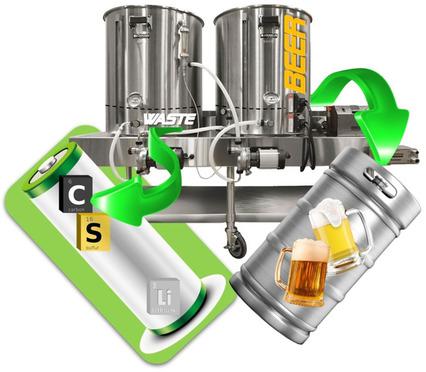当前位置:
X-MOL 学术
›
ChemSusChem
›
论文详情
Our official English website, www.x-mol.net, welcomes your
feedback! (Note: you will need to create a separate account there.)
Simple and Sustainable Preparation of Nonactivated Porous Carbon from Brewing Waste for High-Performance Lithium-Sulfur Batteries.
ChemSusChem ( IF 7.5 ) Pub Date : 2020-05-15 , DOI: 10.1002/cssc.202000969 Alvaro Y Tesio 1 , Juan Luis Gómez-Cámer 2 , Julián Morales 2 , Alvaro Caballero 2
ChemSusChem ( IF 7.5 ) Pub Date : 2020-05-15 , DOI: 10.1002/cssc.202000969 Alvaro Y Tesio 1 , Juan Luis Gómez-Cámer 2 , Julián Morales 2 , Alvaro Caballero 2
Affiliation

|
The development of renewable energy sources requires the parallel development of sustainable energy storage systems because of its noncontinuous production. Even the most‐used battery on the planet, the lithium‐ion battery, is reaching its technological limit. In light of this, lithium–sulfur batteries have emerged as one of the most promising technologies to address this problem. The use of biomass to produce cathodes for these batteries addresses not only the aforementioned problem, but it also reduces the carbon footprint and gives added value to something normally considered waste. Here, the production, by simple and nonactivating pyrolysis, of a carbon material using the abundant “after‐boiling waste” derived from beer brewing is reported. After adding a high sulfur loading (70 %) to this biowaste‐derived carbon by the “melt diffusion” method, the sulfur–carbon composite is used as an effective cathode in Li–S batteries. The cathode shows excellent performance, reaching high capacity values with long‐term cyclability at high current—847 mAh g−1 at 1 C, 586 mAh g−1 at 2 C, and even 498 mAh g−1 at 5 C after 400 cycles—drastically reducing capacity loss to values approaching 0.01 % per cycle. This work demonstrates the possibility of obtaining low‐cost, highly sustainable cathodic materials for the design of advanced energy storage systems.
中文翻译:

从高性能锂硫电池的酿造废料中简单而可持续地制备非活性多孔碳。
由于可再生能源的生产是不连续的,因此需要同时发展可持续的能源存储系统。即使是地球上最常用的电池,锂离子电池也已达到其技术极限。有鉴于此,锂硫电池已经成为解决这一问题的最有前途的技术之一。使用生物质生产这些电池的阴极不仅解决了上述问题,而且还减少了碳足迹,并为通常被认为是废物的东西增加了价值。在此,报道了通过简单且非活化的热解,利用源自啤酒酿造的大量“沸腾后废物”生产碳材料。通过“熔体扩散”方法向这种生物废物衍生的碳中添加高硫负荷(70%)后,硫碳复合物被用作Li-S电池的有效阴极。阴极表现出卓越的性能,在高电流(847 mAh g)下达到了高容量值并具有长期可循环性-1 1个C,586毫安克-1在2℃,甚至498毫安克-1 400次循环,大大减少容量损失到接近每个周期0.01%值之后在5℃。这项工作表明,有可能获得低成本,高度可持续的阴极材料来设计先进的储能系统。
更新日期:2020-07-07
中文翻译:

从高性能锂硫电池的酿造废料中简单而可持续地制备非活性多孔碳。
由于可再生能源的生产是不连续的,因此需要同时发展可持续的能源存储系统。即使是地球上最常用的电池,锂离子电池也已达到其技术极限。有鉴于此,锂硫电池已经成为解决这一问题的最有前途的技术之一。使用生物质生产这些电池的阴极不仅解决了上述问题,而且还减少了碳足迹,并为通常被认为是废物的东西增加了价值。在此,报道了通过简单且非活化的热解,利用源自啤酒酿造的大量“沸腾后废物”生产碳材料。通过“熔体扩散”方法向这种生物废物衍生的碳中添加高硫负荷(70%)后,硫碳复合物被用作Li-S电池的有效阴极。阴极表现出卓越的性能,在高电流(847 mAh g)下达到了高容量值并具有长期可循环性-1 1个C,586毫安克-1在2℃,甚至498毫安克-1 400次循环,大大减少容量损失到接近每个周期0.01%值之后在5℃。这项工作表明,有可能获得低成本,高度可持续的阴极材料来设计先进的储能系统。











































 京公网安备 11010802027423号
京公网安备 11010802027423号